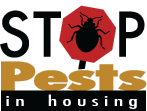What Is IPM?
Pests need food, water, and a place to hide. Take these away and you begin to solve the pest problem in a sustainable way. Integrated pest management (IPM) is the coordinated use of pest and environmental information with available pest control methods to prevent unacceptable levels of pest infestation by the most economical means and with the least possible hazard to people, property, and the environment (EPA, 2000). IPM programs focus on preventive measures—getting at the root of the problem before an infestation occurs.
IPM: A Guide for Affordable Housing describes the full process and provides the information you need to make informed decisions about pest management. The U.S. Department of Housing and Urban Development (HUD) suggests housing agencies manage pests using IPM according to PIH Notice 2011-22.
When working with affordable housing properties, StopPests' Consultants use the implementation process we've been refining since 2009.
The IPM process
- Inspect places where pests hide. Look at monitoring devices to determine the extent of the problem and circumstances that might influence control efforts;
- Identify the pest so that control can be targeted;
- Compare your observations to action thresholds and scale the treatment to the level of infestation;
- Treat using at least two compatible control methods:
- Cultural: changing behaviors (i.e., recycling bottles and cans promptly, rather than storing them at home where they provide food and shelter for pests);
- Physical: trapping pests or blocking them out;
- Biological: using living things that kill pests; and
- Chemical: using least-risk (in terms of toxicity and risk of exposure) EPA-registered products that will get the job done.
- Evaluate effectiveness to determine whether more control is needed or if the area can return to a regular inspection schedule.
day-to-day IPM
- Everyone on the IPM team inspects for pests.
- Whoever finds a pest calls in a work order, which is coded to be pest-specific. The work order or other recordkeeping system is crucial for tracking problems so that property-wide trends can be identified and addressed.
- A Pest management professional (PMP) or property staff member with pest-control knowledge inspects the area, identifies the problem, and makes a plan for action. The plan includes who will do what.
- At least two control options are used (for example, cleaning the kitchen and setting mouse traps). Pesticides are never the only control tactic. Unit-specific records are put in an IPM log every time a staff member or a PMP works on the problem.
- Team members continue to inspect, monitor, record observations, and follow up. If the initial efforts don't work, team members reevaluate the treatment plan and try a different set of control options. Learning where control was not successful helps an IPM program develop into a system that works for the site.
Share this information with our IPM Factsheet.
